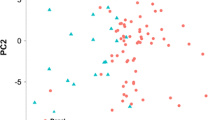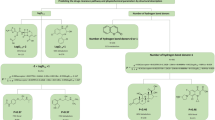Abstract
Biliary excretion is one of the main elimination pathways for drugs and/or their metabolites. Therefore, an insight into the structural profile of cholephilic compounds through accurate modelling of the biliary excretion is important for the estimation of clinical pharmacokinetics in early stages of drug discovery. The aim of this study was to develop quantitative structure-activity relationships as computational tools for the estimation of biliary excretion and identification of the molecular properties controlling this process. The study used percentage of dose excreted intact into bile measured in vivo in rat for a diverse dataset of 217 compounds. Statistical techniques were multiple linear regression analysis, regression trees, random forest and boosted trees. A simple regression tree model generated using the CART algorithm was the most accurate in the estimation of the percentage of bile excretion of compounds, and this outperformed the more sophisticated boosted trees and random forest techniques. Analysis of the outliers indicated that the models perform best when lipophilicity is not too extreme (log P < 5.35) and for compounds with molecular weight above 280 Da. Molecular descriptors selected by all these models including the top ten incorporated in boosted trees and random forest indicated a higher biliary excretion for relatively hydrophilic compounds especially if they are anionic or cationic, and have a large molecular size. A statistically validated molecular weight threshold for potentially significant biliary excretion was above 348 Da.




Similar content being viewed by others
References
Rosenbaum SE. Basic pharmacokinetics and pharmacodynamics, an integrated textbook and computer simulations. 1st ed. Hoboken: John Wiley and Sons; 2011.
Rollins DE, Klaassen CD. Biliary excretion of drugs in man. J Clin Pharmacokinet. 1979;4:368–79.
Kullak-Ublick GA, Stieger B, Hagenbuch B, Meier PJ. Hepatic transport of bile salts. Semin Liver Dis. 2000;20:273–92.
Van Montfoort JE, Hagenbuch B, Groothuis GM, Koepsell H, Meier PJ, Meijer DK. Drug uptake systems in liver and kidney. Curr Drug Metab. 2003;4:185–211.
Leabman MK, Huang CC, DeYoung J, Carlson EJ, Taylor TR, De la Cruz M, et al. Natural variation in human membrane transporter genes reveals evolutionary and functional constraints. Proc Natl Acad Sci U S A. 2003;100:5896–901.
Nies AT, Koepsell H, Winter S, Burk O, Klein K, Kerb R, et al. Expression of organic cation transporters OCT1 (SLC22A1) and OCT3 (SLC22A3) is affected by genetic factors and cholestasis in human liver. Hepatology. 2009;50:1227–40.
Trauner M, Boyer JL. Bile salt transporters: molecular characterization, function and regulation. Physiol Rev. 2003;83:633–71.
Morgan RE, Trauner M, van Staden CJ, Lee PH, Ramachandran B, Eschenberg M, et al. Interference with bile salt export pump function is a susceptibility factor for human liver injury in drug development. Toxicol Sci. 2010;118:485–500.
Schinkel AH, Mayer U, Wagenaar E, Mol CA, Deemter LV, Smit JJ, et al. Normal viability and altered pharmacokinetics in mice lacking mdr1-type (drug-transporting) P-glycoproteins. Proc Natl Acad Sci U S A. 1997;94:4028–33.
Merino G, Jonker JW, Wagenaar E, van Herwaarden AE, Schinkel AH. The breast cancer resistance protein (BCRP/ABCG2) affects pharmacokinetics, hepatobiliary excretion and milk secretion of the antibiotic nitrofurantoin. Mol Pharmacol. 2005;67:1758–64.
Hirom PC, Millburn P, Smith RL, Williams RT. Species variations in the threshold molecular-weight factor for the biliary excretion of organic anions. Biochem J. 1972;129:1071–7.
Abou-El-Makarem MM, Millburn P, Smith RL, Williams RT. Biliary excretion in foreign compounds. Species difference in biliary excretion. Biochem J. 1967;105:1269–74.
Crosignani A. Clinical pharmacokinetics of therapeutic bile acids. J Clin Pharmacokinet. 1996;30:333–58.
Neef C, Keulemans KT, Meijer DK. Hepatic uptake and biliary excretion of organic cations–I. Characterization of three new model compounds. Biochem Pharmacol. 1984;33:3977–90.
Feitsma KG. Unequal disposition of enantiomers of the organic cation oxyphenonium in the rat isolated perfused liver. J Pharm Pharmacol. 1989;41:27–31.
Ghafourian T, Barzegar-Jalali M, Dastmalchi S, Khavari-Khorasani T, Hakimiha N, Nokhodchi A. QSPR models for the prediction of apparent volume of distribution. Int J Pharm. 2006;319:82–97.
Luo G, Johnson S, Hsueh M, Zheng J, Hong C, Xin B, et al. In silico prediction of biliary excretion of drugs in rats based on physicochemical properties. Drug Metab Dispos. 2010;38:422–30.
Gandhi YA, Morris ME. Re-evaluation of a quantitative structure pharmacokinetic model for biliary excretion in rats. Drug Metab Dispos. 2012;40:1259–62.
Yang X, Gandhi YA, Duignan DB, Morris ME. Prediction of biliary excretion in rats and humans using molecular weight and quantitative structure–pharmacokinetic relationships. AAPS. 2009;11:511–25.
Breiman L, Friedman JH, Olshen RA, Stone CJ. Classification and regression trees. Monterey: Wadsworth & Brooks/Cole Advanced Books & Software; 1984.
Lewicki P, Hill S. Statistics, methods and applications, a comprehensive reference for science, industry and data mining. 1st ed. USA: StatSoft Inc; 2006.
Breiman L. Random forests. Mach Learn. 2001;45:5–32.
Chen Y, Cameron K, Guzman-Perez A, Perry D, Li D, Gao H. Structure–pharmacokinetic relationship of in vivo rat biliary excretion. Biopharm Drug Dispos. 2010;31:82–90.
Zamek-Gliszczynski MJ, Hoffmaster KA, Humphreys JE, Tian X, Nezasa K, Brouwer KLR. Differential involvement of Mrp2 (Abcc2) and Bcrp (Abcg2) in biliary excretion of 4-methylumbelliferyl glucuronide and sulphate in the rat. J Pharmacol Exp Ther. 2006;319:459–67.
Guha R, Jurs PC. Development of linear, ensemble, and nonlinear models for the prediction and interpretation of the biological activity of a set of PDGFR inhibitors. J Chem Inf Comput Sci. 2004;44:2179–89.
De’ath G, Fabricius KE. Classification and regression trees: a powerful yet simple technique for ecological data analysis. Ecology. 2000;81:3178–92.
Dearden JC, Ghafourian T. Hydrogen bonding parameters for QSAR: comparison of indicator variables, hydrogen bond counts, molecular orbital and other parameters. J Chem Inf Comput Sci. 1999;39:231–5.
Verma RP, Hansch C. A comparison between two polarizability parameters in chemical–biological interactions. Bioorg Med Chem. 2005;13:2355–72.
Proost JH, Roggeveld J, Wierda JM, Meijer DK. Relationship between chemical structure and physicochemical properties of series of bulky organic cations and their hepatic uptake and biliary excretion rates. J Pharmacol Exp Ther. 1997;282:715–26.
Lewis DF, Ito Y. Human CYPs involved in drug metabolism: structures, substrates and binding affinities. Expert Opin Drug Metab Toxicol. 2010;6:661–74.
Smith PA, Sorich MJ, McKinnon RA, Miners JO. In silico insights: chemical and structural characteristics associated with uridine diphosphate glucuronosyltransferase substrate selectivity. Clin Exp Pharmacol Physiol. 2003;30:836–40.
Varma MV, Chang G, Lai Y, Feng B, El-Kattan AF, Litchfield J, et al. Physicochemical property space of hepatobiliary transport and computational models for predicting rat biliary excretion. Drug Metab Dispos. 2012;40:1527–37.
Hansch C, Leo A, Mekapati SB, Kurup A. QSAR and ADME. Bioorg Med Chem. 2004;12:3391–400.
Kerns EH, Di L. Drug-like properties: concepts, structure, design and methods. 1st ed. London: Elsevier; 2008.
van de Waterbeemd H, Smith DA, Jones BC. Lipophilicity in PK design: methyl, ethyl, futile. J Comput Aided Mol Des. 2001;15:273–86.
Obach RS, Lombardo F, Waters NJ. Trend analysis of a database of intravenous pharmacokinetic parameters in humans for 670 drug compounds. Drug Metab Dispos. 2008;36:1385–405.
Newby D, Freitas AA, Ghafourian T. Coping with unbalanced class datasets in oral absorption models. J Chem Inf Model. 2013;53:461–74.
Koepsell H, Gorboulev, Popp C, van Montfoort JE, Meier PJ, Arndt P, et al. Organic cation transporters in the sinusoidal membrane of hepatocytes. In: Hepatobiliary transport from bench to beside. London: Kluwer; 2001. p. 3–15.
Maeda K, Shitara Y, Horie T, Sugiyama Y. Web-based database as a tool to examine drug-drug interactions involving transporters. In: Pang SK, Rodrigues DA, Raimund MP, editors. Enzyme and transporter-based drug-drug interactions. Progress and future challenges. London: Springer; 2010. p. 387–414.
Kirat D, Inoue H, Iwano H, Yokota H, Taniyama H, Kato S. Monocarboxylate transporter 1 (MCT1) in the liver of pre-ruminant and adult bovines. Vet J. 2007;173:124–30.
Halestrap AP, Meredith D. The SLC16 gene family-from monocarboxylate transporters (MCTs) to aromatic amino acid transporters and beyond. Pflugers Arch. 2004;447:619–28.
Millburn R, Smith RL, Williams RT. Biliary excretion of foreign compounds. Biochem J. 1967;105:1275–81.
Murakawa T, Sakamoto H, Fukada S, Konishi T, Nishida M. Pharmacokinetics of fosmidomycin: a new phosphonic acid antibiotic. Antimicrob Agents Chemother. 1982;21:224–30.
Bardsleey-Elliot A, Plosker GL. Nelfinavir an update on its use in HIV infection. Drugs. 2000;59:581–620.
Author information
Authors and Affiliations
Corresponding author
Rights and permissions
About this article
Cite this article
Sharifi, M., Ghafourian, T. Estimation of Biliary Excretion of Foreign Compounds Using Properties of Molecular Structure. AAPS J 16, 65–78 (2014). https://doi.org/10.1208/s12248-013-9541-z
Received:
Accepted:
Published:
Issue Date:
DOI: https://doi.org/10.1208/s12248-013-9541-z




